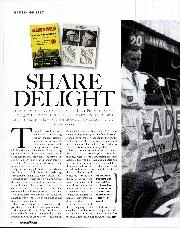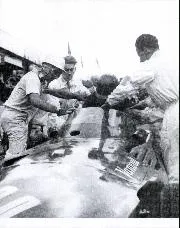He’s not complaining, mind you, just telling us how it was. The fact is, he never complained. Never, ever. At Monaco in 1957, after almost 100 clutch-less laps (24 gearchanges per laps) his “left hand looked like a piece of steak by the finish. Not that you needed an excuse to finish second to Fangio.” At the Nürburgring that same year, while still recovering from his Le Mans injuries, he was physically sick because of the battering the too-stiff Vanwall dished out – yet he finished the race. “I drank 15 cups of tea straight after the finish.” A very British way of rehydrating. Very Tony.
“The engine had lots of torque but it also suffered from a flat spot. It got better during 1958, but it never went completely. It just would not pull smoothly through the rev range. We had to modify our driving style to fit around that problem.” And this was a problem that did not disappear when the four-pot chimed in fully. “Despite the Vanwall’s smooth shape it didn’t have a higher top speed than the Ferrari; Mike Hawthorn’s Dino blew past me on the ‘Ring’s long straight in ’58. Stirling reckoned they were 15mph faster. We definitely lost out to Ferrari with that switch to Avgas [for ’58).”
Clearly, though, it can’t all have been bad. It wasn’t. “The disc brakes were very good and the road-holding was better than the Ferrari’s,” Brooks explains. But it’s also clear that only the best of the best could extract the maximum from these bulbous cars.
“If you went into a corner too quickly in a 250F you could adopt a wider angle of drift; in the Vanwall you just understeered, and all you could do was back off. That made you into a very accurate driver, but it could be very frustrating, too, because you couldn’t adjust the car’s attitude on the throttle. You had to be patient with it. Be very smooth.
“That, of course, was one of the Vanwall’s strengths, too. Don’t forget, spectacular cornering nearly always means slower cornering. The Vanwall went round on a much more geometric line than its rivals, the theoretically ideal line, if you like. Get it right and it was quicker than the 250F. But stray from that line and you had some problems. You had less options, basically.”
Always difficult, occasionally frustrating, but extremely rewarding when done correctly. Moss, the master of any car in any situation, is rightly regarded (by Brooks, too) as the Vanwall benchmark. That Tony ran Stirling so close, and occasionally beat him, puts him right up there – especially when you take into account the circumstances of their partnership.
“Stirling called the shots: he got the engine with the most power and the best-handling chassis. He’d always do more running than me as well. In fact, David Yorke [the team manager] used to restrict my amount of laps, calling me in once I had done a time that was competitive. He wasn’t trying to hamper me, just trying to keep his cars fresh for the race.”
It was not unusual, however, for Tony to start the race in a different ‘fresh’ car from that in which he qualified. “Stirling was constantly swapping cars. He was number one and was entitled to do so; I had signed as number two so I knew what to expect. But it did make it difficult for me at times. But if I’d been number one I would have done exactly what Stirling did.”
There was a synchronicity between this pair: Moss, pushing, cajoling, leading from the front; Brooks, adapting, smoothing, and right at his leader’s shoulder. He was the wingman that fighter aces dream about. He was Chataway to Moss’s Bannister. That is to say, without their combined talents Vanwall would not have broken British motor-racing’s four-minute mile: that first world title.


